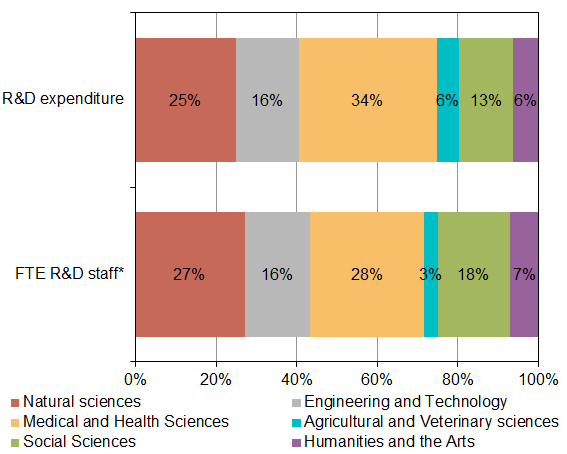R&D in Sweden 2017 – the higher education sector
Staffing cuts in higher education sector R&D activities
Statistical news from Statistics Sweden 2018-10-26 9.30
After several years of increasing, the number of R&D full time equivalent (FTE) personnel in the higher education sector decreased in 2017 to approximately the same level as in 2013. Total R&D expenditure continued to increase in 2017, but R&D expenditure in the field of engineering and technology fell by SEK 188 million, measured in constant 2017 prices.
R&D expenditure in the higher education sector amounted to SEK 38.8 billion in 2017, an increase of SEK 796 million from 2015. R&D expenditure comprises current costs and capital expenditure. R&D current costs increased by SEK 1 billion, while investments decreased by SEK 250 million.
General university funds accounted for the largest share of funding for R&D activities in the higher education sector. The Swedish Research Council and the private non-profit sector were also major financiers. Together, these three organisations contributed 63 percent of total funding. ALF resources, that is, compensation for clinical research carried out at universities’ medical schools, amounted to SEK 1.6 billion in 2017, which is the same level as in 2015.

In the higher education sector, the number of FTEs amounted to 19 096 in 2017, which is a decrease of 939 FTEs compared with 2015. Doctoral students decreased by seven percent and, thus, accounted for approximately half of the decrease. The number of FTEs in the research engineers and laboratory assistants category also decreased in this period. The largest increase, 364 FTEs, or 9 percent, was among researchers. The number of FTEs occupied by non-employed personnel is estimated to be 1 100, which is a decrease compared with 2015.
As in previous years, men occupied 55 percent of the total number of FTEs in the higher education sector, while women occupied 45 percent. Furthermore, men spent about 48 percent of their working hours on R&D, while the corresponding figure for women was 42 percent.

In constant 2017 prices, R&D expenditure in natural sciences and medical and health sciences are the largest fields of science and technology for R&D, both in terms of expenditure and FTEs by R&D personnel. Similarly, these two research areas have seen the largest increases in R&D expenditure between 2015 and 2017. Nevertheless, the largest increase in percentages was in humanities and the arts, where R&D expenditure increased by 13 percent.
The largest decrease was in the field of engineering and technology. After an increase in 2015, spending has decreased by SEK 188 million, bringing expenses back to about the same level as in 2013.
Personnel resources in R&D have decreased in almost all fields of science, except in medical and health sciences. The largest decrease in FTEs by R&D personnel was among employees without an R&D field, where FTEs decreased by 29 percent in 2017 compared with 2015.

*Excluding FTEs by staff without an R&D field
Definitions and explanations
Research and Development (R&D)
Research is defined as systematic work to find new knowledge or ideas with or without an aim or a particular purpose. Development is defined as systematic work that uses research results, scientific knowledge or new ideas to bring about new material, goods, services, processes, systems, methods or significant improvements of those that already exist.
R&D expenditures
R&D expenditures include current expenditures and investments for intramural R&D. Current expenditures refer to labour costs, consultant fees, and other current expenditures. Investments include buildings, land and real estate, machinery and equipment, and software.
FTE (Person-year)
A person-year is the work that one full-time employee does in one year. Therefore, a full-time employee who uses half of their time for R&D in a year has performed 0.5 R&D person-years.
ALF
ALF (Agreement for Medical Training and Research) refers to an agreement about compensation that the central government pays to certain county councils to cover the majority of costs incurred by clinical training and research.
Next publishing will be
2018-11-21 at 09:30.
Statistical Database
More information is available in the Statistical Database
Feel free to use the facts from this statistical news but remember to state Source: Statistics Sweden.
